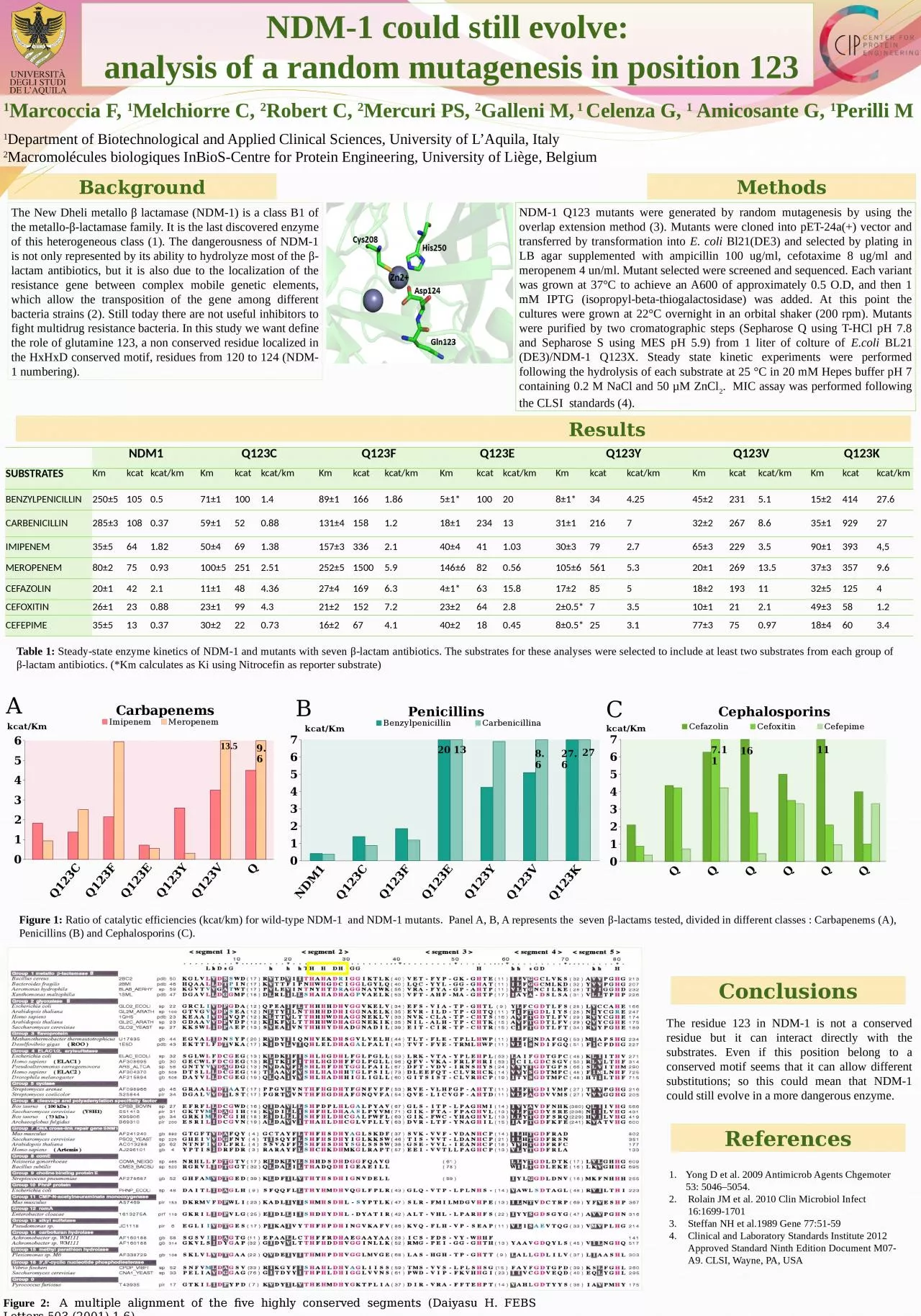

efficiencies kcat km for wildtype NDM1 and NDM1 mutants Panel A B A represents the seven β lactams tested divided in different classes ID: 1047327
Download Presentation The PPT/PDF document "Figure 1: Ratio of catalytic" is the property of its rightful owner. Permission is granted to download and print the materials on this web site for personal, non-commercial use only, and to display it on your personal computer provided you do not modify the materials and that you retain all copyright notices contained in the materials. By downloading content from our website, you accept the terms of this agreement.
1. Figure 1: Ratio of catalytic efficiencies (kcat/km) for wild-type NDM-1 and NDM-1 mutants. Panel A, B, A represents the seven β-lactams tested, divided in different classes : Carbapenems (A), Penicillins (B) and Cephalosporins (C). 20137.111611ACB8.627.627NDM-1 could still evolve: analysis of a random mutagenesis in position 123BackgroundThe New Dheli metallo β lactamase (NDM-1) is a class B1 of the metallo-β-lactamase family. It is the last discovered enzyme of this heterogeneous class (1). The dangerousness of NDM-1 is not only represented by its ability to hydrolyze most of the β-lactam antibiotics, but it is also due to the localization of the resistance gene between complex mobile genetic elements, which allow the transposition of the gene among different bacteria strains (2). Still today there are not useful inhibitors to fight multidrug resistance bacteria. In this study we want define the role of glutamine 123, a non conserved residue localized in the HxHxD conserved motif, residues from 120 to 124 (NDM-1 numbering). MethodsNDM-1 Q123 mutants were generated by random mutagenesis by using the overlap extension method (3). Mutants were cloned into pET-24a(+) vector and transferred by transformation into E. coli Bl21(DE3) and selected by plating in LB agar supplemented with ampicillin 100 ug/ml, cefotaxime 8 ug/ml and meropenem 4 un/ml. Mutant selected were screened and sequenced. Each variant was grown at 37°C to achieve an A600 of approximately 0.5 O.D, and then 1 mM IPTG (isopropyl-beta-thiogalactosidase) was added. At this point the cultures were grown at 22°C overnight in an orbital shaker (200 rpm). Mutants were purified by two cromatographic steps (Sepharose Q using T-HCl pH 7.8 and Sepharose S using MES pH 5.9) from 1 liter of colture of E.coli BL21 (DE3)/NDM-1 Q123X. Steady state kinetic experiments were performed following the hydrolysis of each substrate at 25 °C in 20 mM Hepes buffer pH 7 containing 0.2 M NaCl and 50 µM ZnCl2. MIC assay was performed following the CLSI standards (4).ConclusionsThe residue 123 in NDM-1 is not a conserved residue but it can interact directly with the substrates. Even if this position belong to a conserved motif seems that it can allow different substitutions; so this could mean that NDM-1 could still evolve in a more dangerous enzyme.ReferencesYong D et al. 2009 Antimicrob Agents Chgemoter 53: 5046–5054.Rolain JM et al. 2010 Clin Microbiol Infect 16:1699-1701Steffan NH et al.1989 Gene 77:51-59Clinical and Laboratory Standards Institute 2012 Approved Standard Ninth Edition Document M07-A9. CLSI, Wayne, PA, USA ResultsNDM1Q123CQ123FQ123EQ123YQ123VQ123KSUBSTRATESKmkcatkcat/kmKmkcatkcat/kmKmkcatkcat/kmKmkcatkcat/kmKmkcatkcat/kmKmkcatkcat/kmKmkcatkcat/kmBENZYLPENICILLIN250±51050.571±11001.489±11661.865±1*100208±1*344.2545±22315.115±241427.6CARBENICILLIN285±31080.3759±1520.88131±41581.218±12341331±1216732±22678.635±192927IMIPENEM35±5641.8250±4691.38157±33362.140±4411.0330±3792.765±32293.590±13934,5MEROPENEM80±2750.93100±52512.51252±515005.9146±6820.56105±65615.320±126913.537±33579.6CEFAZOLIN20±1422.111±1484.3627±41696.34±1*6315.817±285518±21931132±51254CEFOXITIN26±1230.8823±1994.321±21527.223±2642.82±0.5*73.510±1212.149±3581.2CEFEPIME35±5130.3730±2220.7316±2674.140±2180.458±0.5*253.177±3750.9718±4603.4Table 1: Steady-state enzyme kinetics of NDM-1 and mutants with seven β-lactam antibiotics. The substrates for these analyses were selected to include at least two substrates from each group of β-lactam antibiotics. (*Km calculates as Ki using Nitrocefin as reporter substrate) 1Marcoccia F, 1Melchiorre C, 2Robert C, 2Mercuri PS, 2Galleni M, 1 Celenza G, 1 Amicosante G, 1Perilli M1Department of Biotechnological and Applied Clinical Sciences, University of L’Aquila, Italy2Macromolécules biologiques InBioS-Centre for Protein Engineering, University of Liège, BelgiumFigure 2: A multiple alignment of the five highly conserved segments (Daiyasu H. FEBS Letters 503 (2001) 1-6)